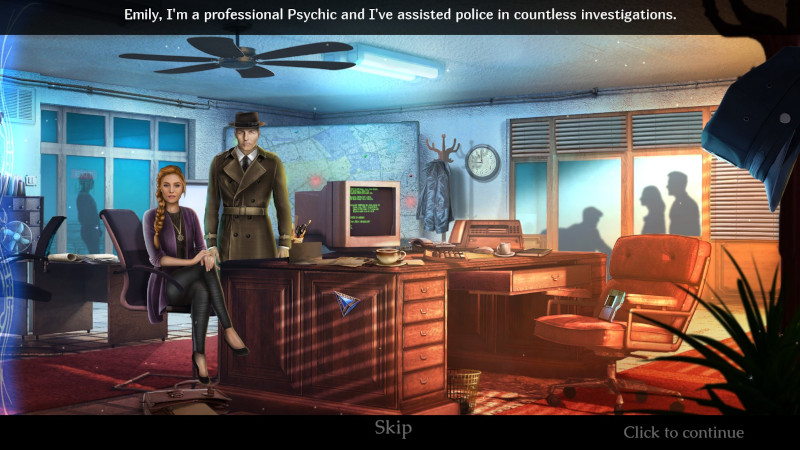|
Ghost Files: The Face of Guilt (Collector's Edition)
Year Published: 2017
Publisher: Artifex Mundi
Developer: Brave Giant Studio
|
Ghost Files: The Face of Guilt is a standard entry in the "Murder Mystery with Supernatural Elements" subgenre of hidden object games. It is a collaboration of Artifex Mundi and Brave Giant Studio and the second game of theirs from 2017 that I have reviewed, the other being Tiny Tales. Much like that game, it carries their production values (but with a few translation quirks and bugs), yet ultimately feels like it's been done before and done better.

Emily don't want none of your psychic mumbojumbo.
As Detective Emily Meyer of the Boston PD, you are investigating a series of murders all believed to be the work of the same killer. The police have hired a psychic to help, and I guess the Boston setting is to explain her accent. Skeptical Meyer quickly dismisses the psychic and, after receiving a tip about the killer's identity, begins her adventure of finding items, using items, and solving puzzles to bring him to justice.
Despite its title, the majority of Ghost Files plays like a straight-laced police procedural. Meyer even possesses a trusty forensics kit that she uses to examine and compare fingerprints, blood stains, and bullet shells. But we know that psychic was introduced for a reason, so it isn't long before Detective Meyer is shot and finds her soul trapped in "Limbo" - a world between the living and the dead where she needs the psychic's help to escape. In Limbo, the forensics kit is replaced with a magical pyramid that Meyer uses to cast spells on stubborn obstacles that block her progress.
There are only a couple of times Meyer enters Limbo, and the bonus chapter takes place entirely there, but they feel out-of-place - like the two subgenres are trying to meld and not all that successfully. The title also refers to the fact that Meyer's suspect appears to have died years ago, making it seem like she's chasing a ghost. I surmised he wasn't supernatural when I saw that he needed to drive a getaway car. However, the actual explanation for his existence is so ridiculously convoluted that I would've believed it more if he was a ghost.

Okay, maybe Emily does need your psychic mumbojumbo now.
Much like other Brave Giant games, the artwork looks okay, though it's not mind-blowing - the supernatural environments of the Limbo worlds are the most interesting and visually satisfying. The character art is almost as mismatched as the genres - they typically appear as 2D hand-drawn images, but are rendered as low poly 3D models for driving and walking around. The 2D closeups look weird, like they transposed a real person's face over a paper cut-out.
There is voice acting, though some of it is cringeworthy, and I believe that's the result of one person who is not a professional actor altering their voice for different roles. The cutscenes that occur when you complete tasks or move between screens is where most of the effort was funneled. Open a locked door and you might catch a glimpse of a suspect running off into the distance. The ending, however, is about three seconds long - so much setup for so little reward.

I swear I've seen this exact background in another hidden object game, but I can't remember which one.
The most positive aspect of Ghost Files is the surprising level of variety in the hidden object scenes - it's as though it took a cue from the Hidden Expedition series. Some are lists, some are silhouettes, some are those types where you find an item and then use that item to find the next one. The puzzles, however, suffer from being simple and derivative - we have a piano puzzle, turning on all the lights (clicking one affects others), rotating rings to form an image, Cat's Cradles, and retrieving a broken key from a lock by sliding a newspaper under the door, amongst other old standbys. (Strangely, the Big Fish Games walkthrough indicates a driving minigame that is not present in the Steam version.)
Ghost Files also has a curious case of "amnesia", with the most blatant example being the tutorial mentioning that if the edge of the screen is highlighted, you can click on it to scroll over and see more. This only ever happens on the first screen. Why introduce this concept if you're not going to ever use it again? Some items in the hidden object scenes are "morphing items", and they only become highlighted on your list when they have transformed into the correct object. However, from about the midpoint on they are always highlighted, making it unclear if what you're looking for is morphing or not. I can't imagine this mechanic was dropped halfway through on purpose. I also encountered a bug where the exit to an area accessed with a grappling hook disappeared. Thankfully, the map's fast travel feature got around it.

Now this is a ghost, but there's not enough of these in here.
I originally played Ghost Files back in 2020, but could not remember anything about it. Upon replaying it, I could see why, as it's so similar to so many other hidden object games that it just didn't stand out in my memory.
I would've hoped a game called "Ghost Files" would actually have more supernatural elements than just "detective has a near death experience to solve a Scooby Doo-level mystery". I'm curious to know if its sequel does, but I guess I'll find out if and when I decide to play it.
SCORE: 2.5/5
|





